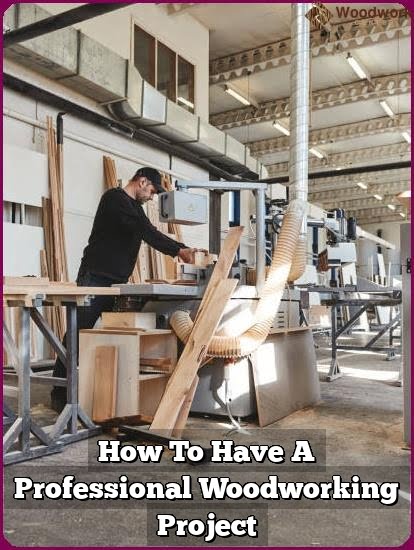Introduction
This post is a guide to professional woodworking for beginners. It provides an overview of all the basic principles and techniques needed to get started in professional standard woodworking. This post will cover topics such as tools and materials selection, cutting accurately, understanding joinery techniques and finishing techniques. The overall purpose of this guide is to provide readers with the information and confidence needed to begin their own professional woodworking projects confidently. With this knowledge, readers will be able to build beautiful furniture, cabinets or other items using quality materials and appropriate craftsmanship.
Types of Woodworking Projects
A great starter project for woodworking beginners is a simple bookcase. To complete this project, you will need wood screws, wood glue, straight edge saw, drill and drill bits, hammer, clamps, and sandpaper. Depending on your skill level, it may take around 4 hours to build a basic bookcase with 3 shelves and 16 inches in height.
Another popular project for beginners is making a birdhouse. For this project you will need an assortment of drill bits and saws like coping saws, jig saws, bandsaws and handsaws; wood screws; wood glue; beads or decorative paint; clamps; a razor blade or X-acto Knife; hammer and nails; metal hardware such as hinges or even masonry hardware like anchor bolts. This particular project does require more skill because of the complexity of the decorative details and in general can take about 10 hours to complete.
An outdoor bench is another great beginner’s project suitable for almost any garden. The materials needed includes pressure treated lumber such as cedar or redwood (for outdoor use); marine varnish (if you plan to leave it outside); Phillips head screwdriver with machine screws; jigsaw for cutting curves into the bench design if desired; long 2x4s for framing the sides with plywood planks supporting them; 2×6’s cut lengthwise into two pieces along face grain line to be used as seat slats; basic hand tools such as hand saws, chisels and planes (for fixing bends in the beams). The approximate time it takes to construct an outdoor bench depends on how detailed or elaborate the design is – usually staff range from 8-12 hours depending on the complexity of design.
Necessary Tools
Power tools can help make woodworking a much easier and faster process, though it’s important to remember safety first when operating them. For example, if you plan to use a table saw for cutting hard materials, you should ensure that the device is properly adjusted according to the manufacturer’s instructions and that you have securely fastened the substrate in place with clamps before beginning operations. You should also wear protective eyewear and gloves when using power tools to protect your eyes from flying debris and your hands from being injured or burned by the machinery. Additionally, many power tools feature guards that will help prevent any accidents occurring while in use. Follow these guidelines whenever using power tools and be sure to keep all blades sharpened regularly for the safest experience possible.
Wood Selections
The use of good quality wood is essential to the success of any woodworking project. One of the main considerations for wood selection is its availability – it is important to make sure that the type of lumber you need is accessible. The availability of different types of wood will influence what kind you use and determine how much you spend on the project, so it pays to shop around and compare options. Additionally, purchasing a large quantity in one go can help save money, although this will depend on usage and storage needs.
Possible sources for obtaining lumber include hardware stores, home improvement centers (like Home Depot or Lowes), online suppliers or specialty retailers. Many specialty retailers carry higher quality products that may cost more but yield better results than lower grade material available at hardware stores. If possible, visiting a local lumberyard or sawmill will often provide a wider variety of wood grades and species from which to choose from as well as more personalized service for custom orders. Online suppliers may also offer more specific materials than those available locally, but be sure to ask about shipping costs when ordering from this source.
Preparing For Your Project
When beginning a woodworking project, it is important to take the proper steps to ensure everything goes as smoothly as possible. Before starting, make sure you measure and plan for the dimensions of each piece of wood you will be working with. Measuring should include double-checking your dimensions in order to avoid any costly mistakes when it comes time to begin construction. Additionally, it is a good idea to mark or label each piece using an identifying character or symbol so that they can be quickly identified at any point during the construction process.
Clamps are another important tool when performing professional woodworking projects, and applying them correctly can also help to ensure accuracy during construction. There are a number of different clamp types available depending on the specific task at hand, such as F-clamps for holding two pieces together if glue drying is required and G-clamps for securing a saw or router in place while cutting away material. It’s also worth investing in a set of French clamps for problem areas quickly requiring attention while working with thicker stock.
Finally, using measuring tape, rulers and other straight edge rulers will ensure that all sides are even before assembly begins. Rulers are perfect for right angle measurements too which will help make sure cuts match up properly once joined together. When taking measurements make sure that your tape measure is perpendicular both on the start and end points of measurement just so nothing falls between 0.1 millimeter either way within the dimension span.
Joining Techniques
Joining techniques are an essential part of any woodworking project, regardless of the level of the craftsman. There are several primary ways that wood is joined together, each with their own strengths and weaknesses. These techniques include butt joints, dado cuts, dovetails, dowels and biscuit joinery.
Butt Joints – A butt joint requires two pieces of wood to be cut in a perpendicular 90 degree angle. This joint is held most securely with glue and nails or screws as needed or desired.
Dado Cuts – Dado cuts involve cutting a groove into one piece of wood and then inserting another wooden piece into it. This type of technique works well for table tops or sides that may be visible when joined together properly.
Dovetails – Dovetail joints require both precision cutting and marking on each side of two pieces of wood to fit back together perfectly like puzzle pieces. Because this technique allows for mechanical fasteners such as screws and nails to be used in addition to the joinery itself, it is a very secure option for drawers, cabinets and other projects where strength is necessary.
Dowels – Dowel joinery may require sophisticated jigs but can also be done free hand by drilling holes into each part of what will become the joint to insert doweling rods between them. Doweling with glue can make an incredibly strong connection for large items like tables or chairs.
Biscuit Joinery – Biscuits are small oval-shaped pieces of hardwood that get inserted into slots cut into corresponding parts before being clamped tightly between the two parts while the glue sets over time. Biscuits provide immense clamping strength without having to use visible mechanical fasteners such as screws or nails making them ideal for furniture pieces that need to look seamless after joining two separate parts together.
Finishing
Engraving – Engraving is a process of creating markings on wood that involves using sharp, pointed chisels to carve out certain designs onto the wood surface. It can be a decorative way of adding text or imagery to your project. Stenciling – Stenciling is a craft where you trace or paint patterns onto a surface using stencils as templates. By carefully placing cutout shapes on the wood, you can create interesting and intricate designs with multiple colors. Lacquers and Waxes – Applying lacquers or waxes to wood is an excellent way to protect it from wear and tear, and enhance its natural look. Lacquers are especially useful in preserving deeper colors and protecting against moisture, while waxes are more for adding details like highlights or subtle aspects like grain patterns to appear more prominent.
Common Mistakes
In addition to avoiding mistakes, learning how to repair them should be an important part of professional woodworking for beginners. It’s not possible to plan and prepare for every eventuality, and mistakes are often made in the beginning stages of a project. Mistakes can range from minor ones like using the wrong wood grain or glue type, to major errors such as misreading measurements or incorrectly aligning parts. Whatever the mistake may be, it is helpful to know what steps can be taken in order to fix them. There may also be times when consultation with a more experienced woodworker or professional is necessary in order for a fix to be successfully implemented.
Another great skill for any beginner woodworker to have is the ability create mock-ups prior to starting the actual project. Crafting a mock-up corrects any problems that were missed during the planning stage, allows accurate estimates regarding materials needed, and gives an idea how wooden parts need to fit together neatly before permanently joining them together. This kind of practice will save time, money, and potentially further frustration down the line.
Lastly yet importantly, one should not hesitate getting help from experienced woodworking professionals when first embarking on the journey of professional woodworking. The majority of those who are more experienced in this craft are often very eager and open about helping others navigate this field because they too had mentors who assisted their own training at some point or another. Do not feel shy about seeking out guidance – it will only make you better!
Closing
As we’ve seen, professional woodworking can be a rewarding and enjoyable experience! It requires patience, practice, and dedication to learn the necessary skills, but with the right resources, any beginner can make their way into this rewarding trade. With a little bit of guidance and support from experienced woodworkers or online communities for woodworkers, anyone can become an expert in this hobby. By accessing resources to help further your growth as an amateur woodworker, you can hone your skills and create pieces worthy of professional standards.
We hope that this blog post has served as a helpful introductory guideline on how to get started on learning professional woodworking. We encourage all future(and current) woodworkers to join online communities or explore additional resources for learning more about woodworking so that you may get the most out of your projects. Let’s start a discussion in the comments – what tips do you have for newbie woodworkers?

Hi everyone! I’m a woodworker and blogger, and this is my woodworking blog. In my blog, I share tips and tricks for woodworkers of all skill levels, as well as project ideas that you can try yourself.





